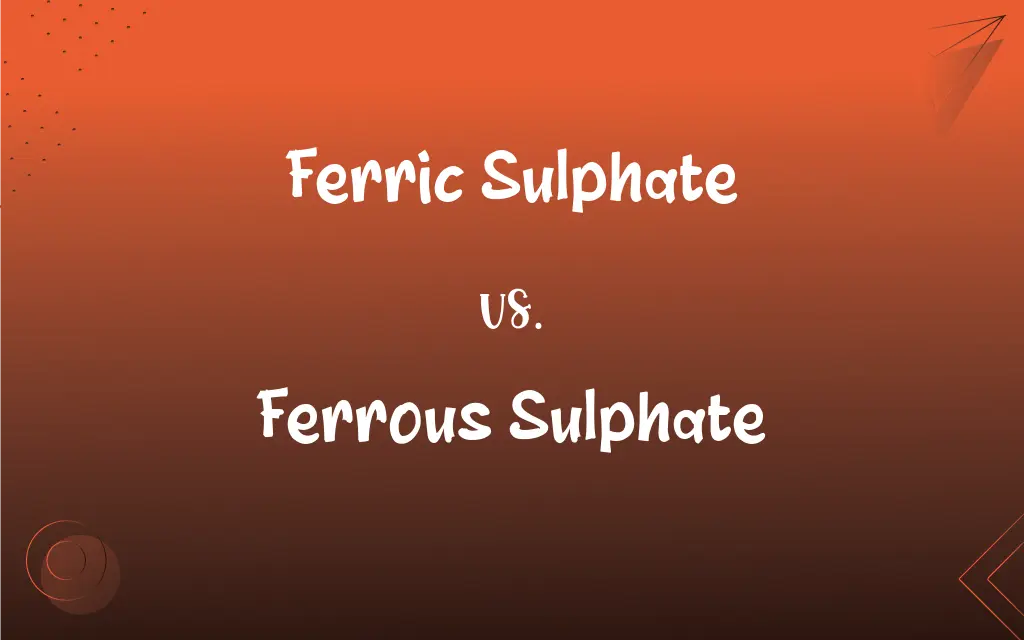Ferric Sulphate vs. Ferrous Sulphate: What's the Difference?
Edited by Aimie Carlson || By Janet White || Published on February 20, 2024
Ferric sulphate contains iron in a +3 oxidation state, whereas ferrous sulphate contains iron in a +2 oxidation state.

Key Differences
Ferric sulphate is a compound with iron in a +3 oxidation state, often used in water treatment and as a coagulant. Ferrous sulphate, containing iron in a +2 state, is commonly used as a nutritional supplement and in fortifying foods.
In ferric sulphate, the iron atom has lost three electrons, giving it unique chemical properties like being a stronger oxidizing agent. Ferrous sulphate, with iron having lost two electrons, has different reactivity and is more easily absorbed in biological systems.
Ferric sulphate is widely used in wastewater treatment, due to its effectiveness in removing impurities. Ferrous sulphate finds extensive use in the agricultural industry as a soil conditioner and nutrient.
The appearance of ferric sulphate is typically yellowish to brown, indicative of the higher oxidation state of iron. Ferrous sulphate usually appears as blue-green crystals, reflecting its different chemical structure.
Handling ferric sulphate requires caution due to its oxidizing nature, while ferrous sulphate, although less hazardous, still needs careful handling especially in high doses due to the risk of iron overload in the body.
ADVERTISEMENT
Comparison Chart
Oxidation State of Iron
+3
+2
Color
Yellowish to brown
Blue-green crystals
Primary Use
Water treatment, coagulant
Nutritional supplement, soil conditioner
Solubility in Water
Moderately soluble
Highly soluble
Safety Considerations
Requires caution due to oxidizing nature
Care needed to avoid iron overload in high doses
ADVERTISEMENT
Ferric Sulphate and Ferrous Sulphate Definitions
Ferric Sulphate
Ferric sulphate serves as an oxidizing agent in various chemical reactions.
Ferric sulphate was used to oxidize the contaminants in the chemical sample.
Ferrous Sulphate
It appears as blue-green crystals or granules, chemically known as FeSO4.
In the experiment, we measured the solubility of ferrous sulphate crystals.
Ferric Sulphate
Ferric sulphate is an inorganic compound used as a coagulant in water treatment.
The city's water treatment plant uses ferric sulphate to clarify drinking water.
Ferrous Sulphate
Ferrous sulphate is a mineral supplement used to treat iron deficiency anemia.
The doctor prescribed ferrous sulphate to increase her iron levels.
Ferric Sulphate
It's used in medicine for dermatological treatments.
The dermatologist prescribed a solution with ferric sulphate for skin lesions.
Ferrous Sulphate
This compound serves as a precursor to other iron compounds.
The synthesis of various iron compounds begins with ferrous sulphate.
Ferric Sulphate
This compound is used in pigment production and as a mordant in dyeing.
Ferric sulphate is crucial in achieving certain colorfastness in textile dyeing.
Ferrous Sulphate
It's utilized in the fortification of foods to combat nutritional deficiencies.
Many cereals are fortified with ferrous sulphate to increase their nutritional value.
Ferric Sulphate
It is a yellowish to brown solid with the formula Fe2(SO4)3.
In the laboratory, the students observed the distinct color of ferric sulphate.
Ferrous Sulphate
Ferrous sulphate is used as a soil conditioner in agriculture.
Farmers often use ferrous sulphate to enrich their soil with iron.
FAQs
Is ferric sulphate safe to handle?
Caution is needed as it can cause skin irritation and is harmful if ingested.
What is the role of ferric sulphate in water treatment?
It acts as a coagulant, helping to remove impurities and clarify water.
What is ferric sulphate?
Ferric sulphate is a chemical compound with the formula Fe2(SO4)3, used primarily as a coagulant in water treatment.
What are the key uses of ferric sulphate?
Its main uses include water purification, wastewater treatment, and as a mordant in dyeing.
How does ferric sulphate differ from ferrous sulphate?
Ferric sulphate contains iron in a +3 oxidation state, whereas ferrous sulphate has iron in a +2 state.
What are the environmental impacts of ferric sulphate?
It can be harmful to aquatic life and must be managed carefully in wastewater.
How is ferric sulphate produced?
It's typically made by reacting sulfuric acid with an oxidized form of iron.
Can ferric sulphate be used in agriculture?
It's not commonly used in agriculture due to its potential toxicity.
Is ferrous sulphate safe for consumption?
Yes, in controlled doses, it's safe as an iron supplement.
What is ferrous sulphate?
Ferrous sulphate, or iron(II) sulphate, is a chemical compound with the formula FeSO4, used mainly as a nutrient and medication.
What are the primary uses of ferrous sulphate?
It's used as a dietary supplement for iron deficiency and in water treatment as a coagulant.
What are the environmental considerations for ferrous sulphate?
It can pose risks to aquatic life and should be carefully managed to avoid runoff into waterways.
Is ferric sulphate soluble in water?
Yes, it is moderately soluble in water.
How is ferrous sulphate produced?
It's commonly produced by treating iron with sulphuric acid.
What is the difference in iron oxidation states in ferric and ferrous sulphate?
Ferrous sulphate contains iron in the +2 oxidation state, while ferric sulphate has iron in the +3 state.
Is ferrous sulphate soluble in water?
Yes, it is highly soluble in water.
How is ferric sulphate stored?
It should be stored in a cool, dry, well-ventilated area away from incompatible materials.
Can ferrous sulphate be used in water purification?
Yes, it's used as a coagulant to remove impurities from water.
What precautions should be taken when handling ferrous sulphate?
Avoid inhalation and direct contact; it can be irritating to skin and eyes.
How does ferrous sulphate benefit plants?
It provides iron, essential for chlorophyll synthesis, improving plant health and color.
About Author
Written by
Janet WhiteJanet White has been an esteemed writer and blogger for Difference Wiki. Holding a Master's degree in Science and Medical Journalism from the prestigious Boston University, she has consistently demonstrated her expertise and passion for her field. When she's not immersed in her work, Janet relishes her time exercising, delving into a good book, and cherishing moments with friends and family.
Edited by
Aimie CarlsonAimie Carlson, holding a master's degree in English literature, is a fervent English language enthusiast. She lends her writing talents to Difference Wiki, a prominent website that specializes in comparisons, offering readers insightful analyses that both captivate and inform.






































































